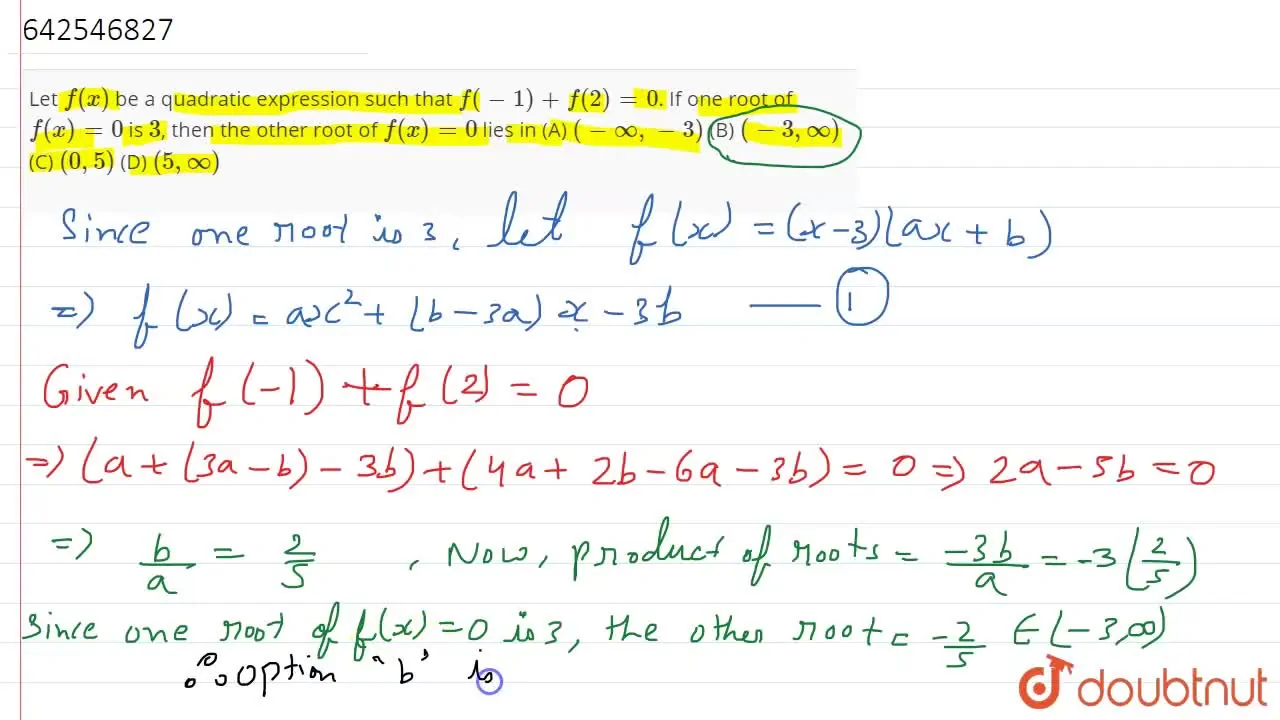Let f(x) be a quadratic expression such that f(−1)+f(2)=0. If one root of f(x)=0 is 3, then the other root of f(x)=0 lies in (A) (−∞,−3) (B) (−3,∞) (C) (0,5) (D) (5,∞)
(−∞,−3)
(−3,∞)
(0,5)
(5,∞)
The correct Answer is:B
(b) Since one root is 3, let
f(x)=(x−3)(ax+b)
⇒f(x)=ax2+(b−3a)x−3b……….(1)
Given, f(−1)+f(2)=0
⇒(a+(3a−b)−3b)+(4a+2b−6a−3b)=0
⇒2a−5b=0
⇒ba=25 ………..(2)
Now, product of roots =−3ba=−3(25)
since one root of f(x)=0 is 3, the oher root =−25∈(−3,0)
Related Playlists
- BOOK - CENGAGE ENGLISHCHAPTER - THEORY OF EQUATIONSEXERCISE - Comprehension12videos
THEORY OF EQUATIONS
- BOOK - CENGAGE ENGLISHCHAPTER - THEORY OF EQUATIONSEXERCISE - Multiple Correct Answer6videos
THEORY OF EQUATIONS
- BOOK - CENGAGE ENGLISHCHAPTER - STRAIGHT LINESEXERCISE - ARCHIVES (NUMERICAL VALUE TYPE)1videos
STRAIGHT LINES
- BOOK - CENGAGE ENGLISHCHAPTER - THREE DIMENSIONAL GEOMETRYEXERCISE - All Questions294videos
THREE DIMENSIONAL GEOMETRY
Similar Questions
Let f(x) be a quadratic polynomial satisfying f(2) + f(4) = 0.
If unity is one root of f(x) = 0 then find the other root.View SolutionIf ex+ef(x)=e , then the range of f(x) is (−∞,1] (b) (−∞,1) (1, ∞) (d) [1,∞)
View SolutionLet f(x)=a2+bx+c where a ,b , c in Randa≠0. It is known that f(5)=−3f(2) and that 3 is a root of f(x)=0. Then find the other of f(x)=0.
View SolutionLet f:(0,∞)→R be a differentiable function such that f'(x)=2−f(x)x for all x∈(0,∞) and f(1)=1, then
View SolutionThe domain of the function f(x)=1√|x|−x is:
(A) (−∞,∞)
(B) (0,∞
(C) (−∞,0)
(D) (−∞,∞)-{0}View SolutionThe range of the function f(x)=|x−1| is
A. (−∞,0)
B. [0,∞)
C. (0,∞)
D. RView SolutionLet f:(0,∞)→R be a differentiable function such that f'(x)=2−f(x)x for all x∈(0,∞) and f(1)=1, then f(x) is
View SolutionThe set of points where the function f(x)=x|x| is differentiable is (−∞,∞) (b) (−∞,0)∪(0,∞) (0,∞) (d) [0,∞)
View SolutionLet f be a function such that f(x).f'(−x)=f(−x).f'(x) for all x and f(0)=3.
Now answer the question:Number of roots of equation f(x)=0 in interval [−2,2] is
(A) 0 (B) 2 (C) 4 (D) 1View SolutionThe domain of the function f(x)=1√|x|−x is: (1) (−∞,∞) (2) (0,∞ (3) (−∞,0) (4) (−∞,∞)-{0}
View Solution


